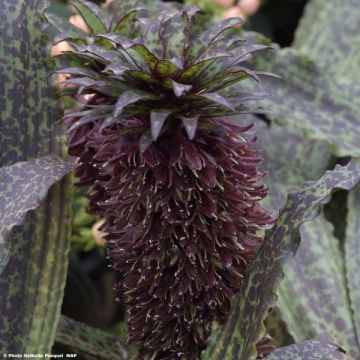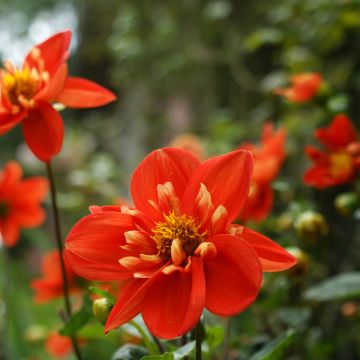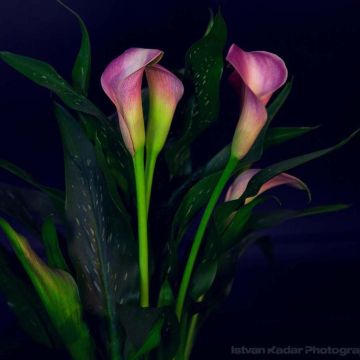

Eucomis bicolor - Variegated pineapple lily


Eucomis bicolor - Variegated pineapple lily


Eucomis bicolor - Variegated pineapple lily
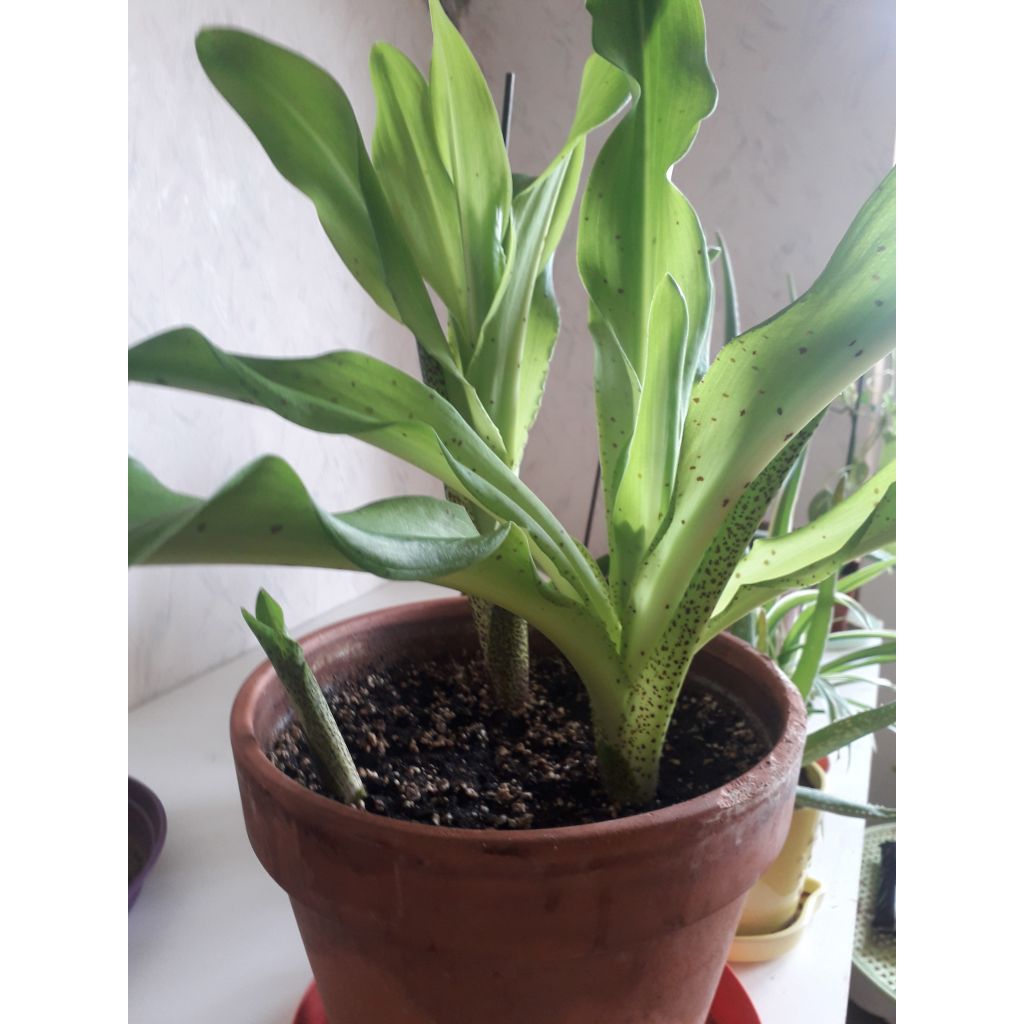

Eucomis bicolor - Variegated pineapple lily
Eucomis bicolor - Variegated pineapple lily
Eucomis bicolor
Pineapple Lily, Two-colour Pineapple Lily, Albuca
The 3 bulbs arrived in very good condition. Only one has bloomed. I hope the others will bloom next year.
Claudine, 23/12/2023
This item cannot be shipped to the selected country
Delivery charge from €5.90
More information
Schedule delivery date,
and select date in basket
This plant carries a 6 months recovery warranty
More information
We guarantee the quality of our plants for a full growing cycle, and will replace at our expense any plant that fails to recover under normal climatic and planting conditions.
From €5.90 for pickup delivery and €6.90 for home delivery
Express home delivery from €8.90.

Does this plant fit my garden?
Set up your Plantfit profile →
Description
The Eucomis bicolor, also known as the Pineapple Lily or Bicolor Eucomis, is an unusual South African bulbous plant, with a somewhat exotic appearance, but easy to grow and integrate with other plants in the garden. In summer, a rosette of large leaves emerges, bearing inflorescences with small flowers in shades of white, purplish pink, and green, topped with a tuft of spring green leaves, resembling the silhouette of a pineapple. Relatively hardy, this perennial can be grown in the ground in regions that are not too cold, as well as in pots to adorn the terrace or balcony.
The Eucomis bicolor belongs to the family of Liliaceae, or Hyacinthaceae according to classifications. Its origins are found in the eastern regions of South Africa, specifically in Transvaal, characterized by dry winters.
It is a herbaceous perennial plant with deciduous foliage in winter, growing from a large bulb that resembles a hyacinth bulb. Over time, it forms a clump of 60 cm (24in) in height when flowering, and occupies approximately 50-60 cm (20-24in) in width on the ground. In spring, its foliage emerges in a voluminous rosette of glossy leaves in fresh green color. Initially small in size, the leaves grow and expand until flowering. They are thick, long, and linear, arranged in a crown around a central axis. It is in the heart of summer (in July-August) that this eucomis unfolds a large fleshy floral spike in green color, dotted with small purple spots. The upper part of this spike is covered with a large head composed of tiny star-shaped flowers, consisting of 6 petals with a waxy texture. Their color is white-green bordered with purplish pink. This inflorescence is topped by a large cluster of bracts resembling leaves, similar to the one found at the top of a pineapple fruit. The entire plant really resembles a pineapple plant. The flowering is followed by the formation of spherical fruits. This plant produces bulblets around the mother bulb, allowing the clump to slowly expand over the years. The vegetation disappears in autumn, while the bulb goes into dormancy in winter, in a soil that remains rather dry.
Plant Eucomis bicolor in rockeries or in well-drained borders, alongside kniphofias, crocosmias, and Gladiolus callianthus for example. It alone forms beautiful borders near pathways. It will also look impressive alongside mulleins (Verbascum), scabious, tall foxgloves, Oriental poppies, grasses... Hardy down to -10°C (14°F), this Eucomis thrives in full sun or partial shade in well-drained soil that remains moist during the growing and flowering period. It is also easy to grow in pots (which allows for overwintering), and its long-lasting flowers make for lovely exotic bouquets.
Report an error about the product description
Eucomis bicolor - Variegated pineapple lily in pictures




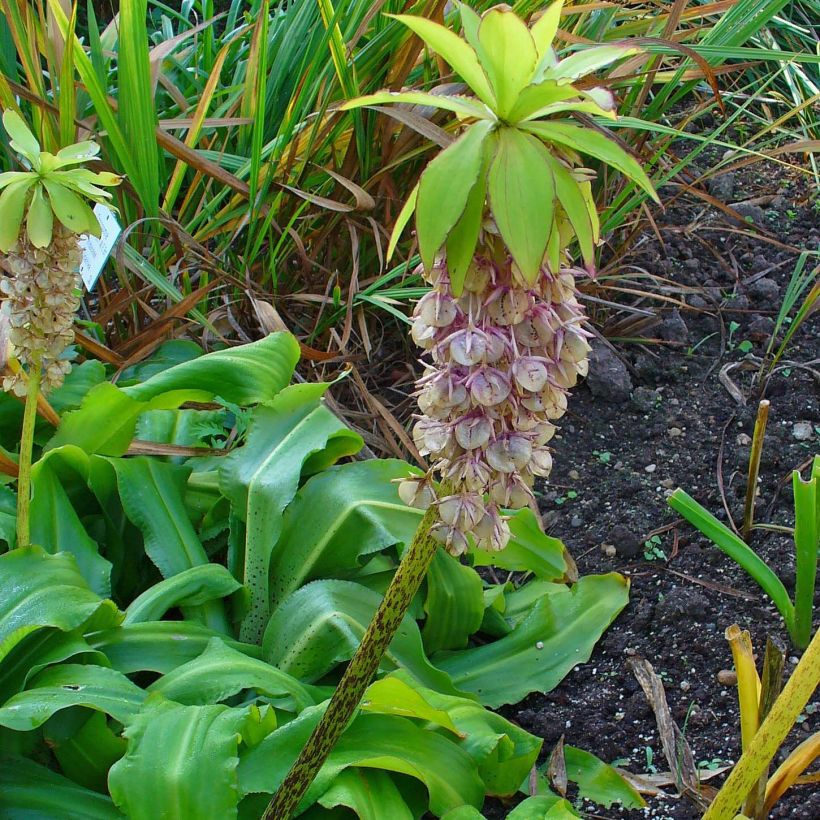

Plant habit
Flowering
Foliage
Botanical data
Eucomis
bicolor
Hyacinthaceae (Liliaceae)
Pineapple Lily, Two-colour Pineapple Lily, Albuca
South Africa
Other Eucomis
Planting and care
Plant the bulbs of the Eucomis bicolor in the spring, quite deeply, at a depth of 15-20 cm (6-8in) in well-drained soil, spaced 30 cm (12in) apart, with the tapered part of the bulb facing upwards. Dig a hole 40-50 cm (16-20in) in all directions, and place a layer of gravel at the bottom for good drainage—Backfill with a mixture of garden soil, compost, and sand. In heavy soil, plant the bulb in pure sand. The plant is hardy to -10 °C in well-drained soil not waterlogged in winter and under a thick layer of dead leaves or straw. Wherever harsh winters are to be feared, mulch the clumps and protect them with a tarp or roof tile. This plant tolerates partial shade well but prefers a sunny exposure that promotes flowering.
Also easy in a pot: 1 bulb per 18 cm (7in) diameter pot of sufficient depth.
Planting period
Intended location
Care
-
, onOrder confirmed
Reply from on Promesse de fleurs
Bulbs to grow in pots
Haven't found what you were looking for?
Hardiness is the lowest winter temperature a plant can endure without suffering serious damage or even dying. However, hardiness is affected by location (a sheltered area, such as a patio), protection (winter cover) and soil type (hardiness is improved by well-drained soil).

Photo Sharing Terms & Conditions
In order to encourage gardeners to interact and share their experiences, Promesse de fleurs offers various media enabling content to be uploaded onto its Site - in particular via the ‘Photo sharing’ module.
The User agrees to refrain from:
- Posting any content that is illegal, prejudicial, insulting, racist, inciteful to hatred, revisionist, contrary to public decency, that infringes on privacy or on the privacy rights of third parties, in particular the publicity rights of persons and goods, intellectual property rights, or the right to privacy.
- Submitting content on behalf of a third party;
- Impersonate the identity of a third party and/or publish any personal information about a third party;
In general, the User undertakes to refrain from any unethical behaviour.
All Content (in particular text, comments, files, images, photos, videos, creative works, etc.), which may be subject to property or intellectual property rights, image or other private rights, shall remain the property of the User, subject to the limited rights granted by the terms of the licence granted by Promesse de fleurs as stated below. Users are at liberty to publish or not to publish such Content on the Site, notably via the ‘Photo Sharing’ facility, and accept that this Content shall be made public and freely accessible, notably on the Internet.
Users further acknowledge, undertake to have ,and guarantee that they hold all necessary rights and permissions to publish such material on the Site, in particular with regard to the legislation in force pertaining to any privacy, property, intellectual property, image, or contractual rights, or rights of any other nature. By publishing such Content on the Site, Users acknowledge accepting full liability as publishers of the Content within the meaning of the law, and grant Promesse de fleurs, free of charge, an inclusive, worldwide licence for the said Content for the entire duration of its publication, including all reproduction, representation, up/downloading, displaying, performing, transmission, and storage rights.
Users also grant permission for their name to be linked to the Content and accept that this link may not always be made available.
By engaging in posting material, Users consent to their Content becoming automatically accessible on the Internet, in particular on other sites and/or blogs and/or web pages of the Promesse de fleurs site, including in particular social pages and the Promesse de fleurs catalogue.
Users may secure the removal of entrusted content free of charge by issuing a simple request via our contact form.
The flowering period indicated on our website applies to countries and regions located in USDA zone 8 (France, the United Kingdom, Ireland, the Netherlands, etc.)
It will vary according to where you live:
- In zones 9 to 10 (Italy, Spain, Greece, etc.), flowering will occur about 2 to 4 weeks earlier.
- In zones 6 to 7 (Germany, Poland, Slovenia, and lower mountainous regions), flowering will be delayed by 2 to 3 weeks.
- In zone 5 (Central Europe, Scandinavia), blooming will be delayed by 3 to 5 weeks.
In temperate climates, pruning of spring-flowering shrubs (forsythia, spireas, etc.) should be done just after flowering.
Pruning of summer-flowering shrubs (Indian Lilac, Perovskia, etc.) can be done in winter or spring.
In cold regions as well as with frost-sensitive plants, avoid pruning too early when severe frosts may still occur.
The planting period indicated on our website applies to countries and regions located in USDA zone 8 (France, United Kingdom, Ireland, Netherlands).
It will vary according to where you live:
- In Mediterranean zones (Marseille, Madrid, Milan, etc.), autumn and winter are the best planting periods.
- In continental zones (Strasbourg, Munich, Vienna, etc.), delay planting by 2 to 3 weeks in spring and bring it forward by 2 to 4 weeks in autumn.
- In mountainous regions (the Alps, Pyrenees, Carpathians, etc.), it is best to plant in late spring (May-June) or late summer (August-September).
The harvesting period indicated on our website applies to countries and regions in USDA zone 8 (France, England, Ireland, the Netherlands).
In colder areas (Scandinavia, Poland, Austria...) fruit and vegetable harvests are likely to be delayed by 3-4 weeks.
In warmer areas (Italy, Spain, Greece, etc.), harvesting will probably take place earlier, depending on weather conditions.
The sowing periods indicated on our website apply to countries and regions within USDA Zone 8 (France, UK, Ireland, Netherlands).
In colder areas (Scandinavia, Poland, Austria...), delay any outdoor sowing by 3-4 weeks, or sow under glass.
In warmer climes (Italy, Spain, Greece, etc.), bring outdoor sowing forward by a few weeks.



































